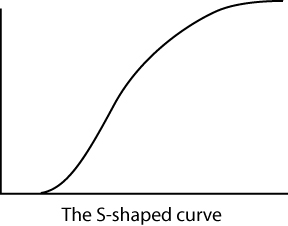 username@email.com
username@email.com
In this lesson you will review the major players of evolution, the evolutionary timeline, and gradualism and punctuated equilibrium. You will also review evolutionary connections determined by convergent evolution and homologous and analogous structures.
Darwin’s work with evolution undeniably launched a scientific journey of research, discovery, and debate. Publishing his book On the Origin of Species in 1859, he introduced the concept of natural selection. Darwin proposed the idea that those with the adaptations best suited for their environment would be reproductively successful. He believed that evolution was a gradual process in which the change of adaptation happened slowly over many generations. According to Darwin, species would always be in a state of transition or continuous evolution.
Working with peas in a monastery garden, Gregor Mendel observed variations in plants across generations. Prior to Mendel’s work, scientists thought that a blending occurred between parents. The blending passed on an “essence” to form the offspring’s characteristics. Studying more than 28,000 plants gave Mendel the information needed to develop two important generalizations. Mendel’s observations led to an understanding of particulate inheritance. He discovered that discrete traits are passed along as an inheritance. Through his research Mendel identified the fundamental laws of inheritance.

Dominant and recessive phenotypes. (1) Parental generation. (2) F 1 generation. (3) F 2 generation. Dominant (red) and recessive (white) phenotype look alike in the F 1 generation and show a 3:1 ratio in the F 2 generation.

The color alleles of Mirabilis jalapa are not dominant or recessive. (1) Parental generation. (2) F 1 generation. (3) F 2 generation. The “red” and “white” allele together make a “pink” phenotype, resulting in a 1:2:1 ratio of red:pink:white in the F 2 generation.
Mendel’s inheritance laws changed the way scientists thought about inheritance. His work was published in 1865; however, it did not receive serious attention until it was re-evaluated 1900.
Geneticist Theodosius Dobzhansky and systematist Ernst Mayr were the next key players in thinking about evolution. In the 1930s and 1940s, they introduced a theory that became known as Modern Synthesis. Reconciling the work of Darwin and Mendel, Modern Synthesis shifts from a focus on individuals, organisms, and speciation to an emphasis on populations, genetics, and phenotypes. The scientists argued that geographic isolation of a small sub-population would gradually lead to the evolution of new genetic traits. Through this gradualism, the changed population becomes unable to interbreed with the original population. Mayr clarified by saying: “Without speciation, there would be no diversification of the organic world, no adaptive radiation, and very little evolutionary progress. The species, then, is the keystone of evolution.”
During the 1960s and 1970s, geologically trained paleontologists brought new research to bear on evolution. Niles Eldredge and Stephen Jay Gould reintroduced ideas about patterns of species’ stability over time. They formulated an argument around the idea of stasis, which means that species remained in the same form, with little or no change, for millions of years. Eldredge and Gould thought that stasis was punctuated by bursts of rapid change during which new species developed. As a result of the rapid changes, little fossil information was left behind. They called the periods of rapid change punctuated equilibrium. Eldredge and Gould demonstrated that most speciation occurred on the fringes of populations. They hypothesized that changes in species were not visible in fossil records because they occurred in very small, isolated populations. The scientists suggested that only new species that were highly successful could leave behind enough fossil evidence in the ancestral range.
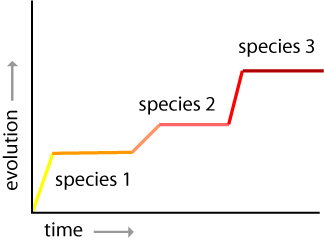
Punctuated Equilibrium
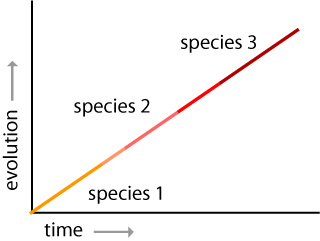
Gradualism
In 1985, Yale University paleontologist Elisabeth Vrba introduced the turnover pulse hypothesis. She suggested that changes in environmental conditions initiate rapid periods of extinctions and new species development. According to Vrba, external factors, such as climate changes, produce major evolutionary shifts. She studied turnover pulse events that occurred 2.5 million years ago in Eastern and Central Africa. She identified global cooling as the cause of significant African ecosystem change. Drier, cooler conditions resulted in a decline of wet woodland habitat and led to large expanses of grasslands. Species like the impala were successful in surviving the change because they were generalists. Other species were not so lucky.
Vrba also described the process of habitat tracking in which species successfully migrated into the changed habitat. She is credited with understanding that ecosystem decay and fragmentation leads to speciation and extinction.
Concurrent to all of this research has been significant breakthroughs in understanding population genetics. In 1952, Frederick Sanger uncovered the first complete protein sequence in insulin. Through his groundbreaking work, science has seen advances in DNA techniques leading to the launch of the Human Genome Project in 1990. This project set out to map the complete sequence of the human chromosome. While it seemed an impossible task, the first human chromosome sequence was published in 1999. The Human Genome Project was completed in 2001.
Closely related to evolutionary biology and phylogeny is the study of differences and similarities between organisms, or comparative anatomy. Comparative anatomy has revealed further proof of evolution. Prior to Darwin’s time, Georges Cuvier was at work gaining significant understanding of anatomy. In the late 1700s, Cuvier argued that every structure of an organism was integral to its survival. Formulating the process of comparative anatomy, Cuvier studied elephants. He compared African and Indian elephants to fossil remains of mammoths. His research led him to believe and prove that some species became extinct. His work became the basis for modern vertebrate paleontology.
Paleontology and comparative anatomy have provided further evidence in the case for evolution. Through comparative anatomy, scientists have observed that some animals share similar structures. Homologous structures are those features shared among a set of related species. The structures are shared because they have been inherited from a common ancestor. For example, the bone structure in a human arm and a bat’s wing are homologous. While each organism has a different use for the limb (writing, flight) the general structure is similar. Scientists agree that this likeness can best be explained by common descent.
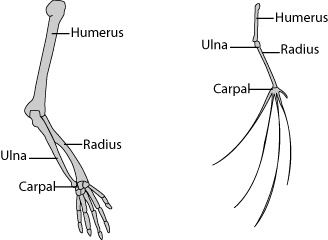
By comparison, analogous structures do not reflect common ancestry. Analogous structures may be superficially similar but are observed in organisms that are completely unrelated. These structures evolved in response to similar environmental factors and they evolved independently. While the structures may have similar functions, they are not the result of a common ancestor. For example, the structure of an insect wing is vastly different from a bird wing. Both will have a competitive advantage by virtue of flight. With the ability to fly an organism gains greater access to food, potential to seasonally migrate, increased access to safe nesting space, and the ability to flee predators.
Analogous structures are an example of convergent evolution. Unrelated species have converged upon a competitive advantage or an adaptation for success in their environment. Marsupials and placentals are two major groups of mammals. They are also an excellent example of convergent evolution. Although they have lived on different continents, they have evolved with some similarities. For example, the groundhog (a placental) has a strong resemblance to the wombat (a marsupial). Additionally, there are both placental and marsupial anteaters, mice, and moles. With very similar body characteristics, the main difference between these groups of mammals is reproduction. The marsupial’s young are born much less developed than placental young. Marsupial young develop to maturity in an external pouch. The placental mammals carry their young internally much longer. When the young are born, they still require significant parental care, though they are significantly more mature than are marsupial young.
Darwin’s theory of evolution and the concept of natural selection played a significant role in scientific understanding of species survival. Those species best adapted for their environment are more likely to be successful in obtaining food and finding a mate. Therefore, they are most likely to pass along their genetic strength to offspring who in turn survive at a greater rate.
Many species display sexual dimorphism, a difference in form between male and female of a species. This attribute enables organisms to locate, attract, and fight for mating. While sexual dimorphism may seem to be a survival disadvantage, reproduction is often more important than long-term survival.
Normally, a large, viable population of a species is able to adapt to changing conditions through genetic variability. The more genetic variation, the greater the potential is for survival. Genetic drift occurs when genetic variation is limited. Small populations are at greater risk for genetic drift or the further erosion of genetic resources. Genetic drift may be the result of selective pressures, geographic isolation, changes in migration, or the establishment of new populations.
Scientists continue to explore the implications of evolution. Scientists propose that when individuals become geographically separated from the main population, they gradually evolve traits that are different from their origins. Through this gradualism, the founder population becomes unable to interbreed with the original population. By contrast, the concept of punctuated equilibrium suggests that populations exhibit long periods of time with relatively little change. These periods are punctuated by sudden genetic changes that forever diversify the population, bringing to an end the opportunities for interbreeding.
Considering the dynamics of entire populations of organisms points to the study of population ecology and its implications for humans and wildlife. Darwin gives much of the credit for the development of his ideas about natural selection to the thinking of Thomas Malthus. Malthus noticed that there were many more offspring produced by organisms than could actually survive. In particular, Malthus considered the capabilities of populations to overproduce. He suspected that a population could not grow unchecked indefinitely. He proposed that populations grow exponentially while food resources grow arithmetically meaning that a population left unchecked would soon outgrow its food resources, thereby creating stress within the population.
Today the study of population ecology examines the numbers of individuals in populations and how populations shift and change over time. Birth rate and death rate are the most basic factors of population growth. The intrinsic rate of increase is measured as the birth rate minus the death rate. The capacity of organisms to reproduce under ideal conditions is called biotic potential. The age an organism reaches sexual maturity, the frequency of reproductive opportunities, and the offspring produced are factors that affect biotic potential.
Humans, elephants, whales, gorillas, and many other large species have low biotic potential. These species take several years to reach sexual maturity. Long gestation periods are needed. Low numbers of offspring are produced as the result. Parental care requires a considerable amount of energy. Offspring often remain under the care of the parents for many years. Low biotic species typically live a long time.
By comparison, insects, amphibians, rodents, marine invertebrates, and parasites are examples of species with high biotic potential. High biotic potential is distinguished by a short lifespan to sexual maturity. Hundreds of offspring might result from mating circumstances. Many offspring are needed because not all will live to reproduce. Little to no parental energy is spent in caring for offspring after hatching. At birth or shortly after, offspring are ready to provide for their own needs. High biotic species generally live a short time.
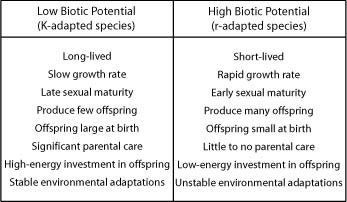
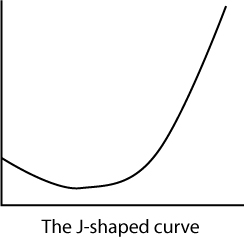
The carrying capacity is different for every environment and its resident organisms. In nature, carrying capacities tend to stabilize over time. Increased death rates result from too many individuals. Too few individuals can lead to increasing population sizes. The carrying capacity of a habitat can limit the population’s potential. If a habitat’s natural resources become limited by drought conditions, for example, population growth also becomes limited. In a graph representing the limiting factors of carrying capacity, the population curve would be reflected as an S. Over time the influence of a habitat’s carrying capacity would act on the population size.
